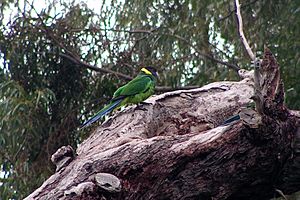Australian ringneck facts for kids
Quick facts for kids Australian ringneck |
|
|---|---|
 |
|
| B. z. barnardi near Patchewollock, Victoria | |
| Conservation status | |
| Scientific classification | |
| Genus: |
Barnardius
|
| Species: |
zonarius
|
| Subspecies | |
|
B. z. zonarius |
|
| Synonyms | |
The Australian ringneck is a type of broad-tailed parrot. Its scientific name is Barnardius zonarius. This bird is originally from Australia. It has learned to live in almost all parts of Australia, except for very hot tropical areas and high mountain regions.
Scientists used to think there were two different species of these parrots: the Port Lincoln parrot and the Mallee ringneck. However, because they can easily have babies together where their living areas meet, they are now usually seen as one single species. This species is called B. zonarius. There are currently four main types, or subspecies, of the Australian ringneck, and each lives in a different area.
In Western Australia, the Australian ringneck sometimes has to compete for nesting spots with the rainbow lorikeet. The rainbow lorikeet is a bird that was brought to Australia from somewhere else. To help protect the ringneck, authorities in Western Australia sometimes remove rainbow lorikeets. Overall, the Australian ringneck is not an endangered species.
Contents
What Does the Australian Ringneck Look Like?
The different types of Australian ringnecks have many different colors. This bird is a medium-sized parrot, usually about 33 centimeters (11 inches) long. Its main color is green. All four types of Australian ringnecks have a special yellow ring around the back of their neck. Their wings and tail are a mix of green and blue colors.
Two of the subspecies, B. z. zonarius and B. z. semitorquatus, have a dull black head. Their back, rump, and wings are a bright green. Their throat and chest are a bluish-green color. The main difference between these two is that B. z. zonarius has a yellow belly, while B. z. semitorquatus has a green belly. The B. z. semitorquatus also has a bright red band on its forehead, which B. z. zonarius does not have.
The other two subspecies look different because they have a bright green top of the head and cheeks. The B. z. barnardi has a blue-green belly with an orange-yellow band across it. Its back is a dark blue-black, and it has a clear red band on its forehead. The B. z. macgillivrayi is generally a pale green color. It does not have a red band on its forehead. It has a wide, light yellow band across its belly.
The sounds these parrots make are also different. The Mallee ringneck and Cloncurry parrot make "ringing" calls. The Port Lincoln ringneck and Twenty-eight parrot make "loud" calls. The Twenty-eight parrot got its name because its call sounds like it is saying "twenty-eight."
Where Does the Australian Ringneck Live?
The Australian ringneck is active during the day. You can find it in forests with eucalypt trees and along water areas lined with eucalypt trees. These birds like to live in groups. Depending on the weather and food, they might stay in one place or move around. Farmers have noticed that these parrots, especially the Port Lincoln parrot, can damage young eucalypt trees.
What Do Australian Ringnecks Eat?
These parrots eat many different kinds of food. Their diet includes flower nectar, insects, seeds, fruits, and even native and introduced plant bulbs. They also enjoy eating fruit grown in orchards, which sometimes makes them a problem for farmers.
How Do Australian Ringnecks Have Babies?
In the northern parts of Australia, the breeding season for these parrots starts in June or July. In central and southern areas, they breed from August to February. However, if the weather is bad, they might delay breeding.
They build their nests inside hollows in tree trunks. Usually, a female parrot lays four or five white, oval-shaped eggs. Each egg is about 29 mm by 23 mm. Sometimes, they lay as few as three eggs or as many as six. About 75% of the baby parrots that hatch survive and leave the nest.
Protecting the Australian Ringneck
Even though the Australian ringneck only lives in Australia, it is not considered an endangered species. However, in Western Australia, the Twenty-eight subspecies (B. z. semitorquatus) sometimes loses its nesting spots. This happens because rainbow lorikeets, which were brought to Australia, are very aggressive and compete for nests. Because of this, rainbow lorikeets are seen as a pest in Western Australia and are sometimes removed from the wild.
In Western Australia, you need a special permit to own or sell more than four Port Lincoln ringnecks. All four subspecies of the Australian ringneck are sold in the Canary Islands and in Australia. Their sale is controlled by the CITES agreement, which helps manage trade in wild animals and plants. The sale of the Cloncurry parrot is limited in Queensland. Australian ringnecks can also get a sickness called psittacine beak and feather disease. This disease can cause many young birds to die when they are kept in captivity.
Images for kids
See also
 In Spanish: Perico de Barnard para niños
In Spanish: Perico de Barnard para niños







